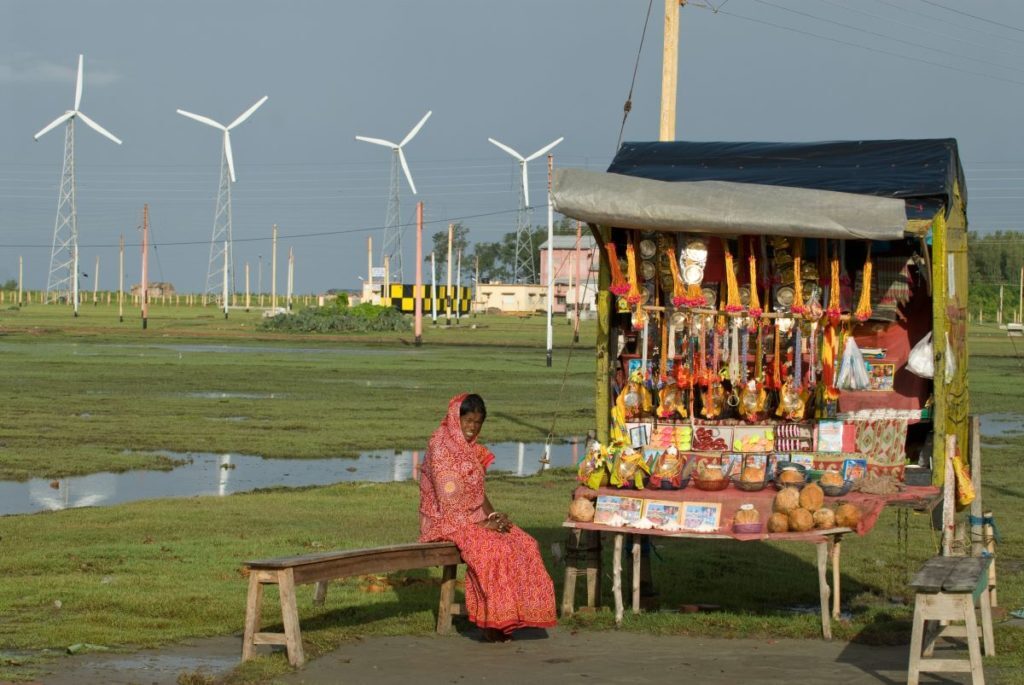Working With Natural Materials To Add To The Sustainable Energy Mix
Jan 31, 2023 | Pratirodh Bureau
A shopkeeper in West Bengal can be seen against the backdrop of windmills. Scientists are turning to natural materials to find solutions to energy security challenges by diversifying the energy basket. While groups working in different corners of India have yielded scientifically interesting results, practical applications remain challenging (Image: Joerg Boethling/Alamy)
To find solutions to energy security challenges, by diversifying the energy basket, scientists are turning to natural materials. The International Energy Agency (IEA) defines energy security as the ‘uninterrupted availability of energy at affordable prices.’ It is a challenge that will likely intensify in the future.
Tiny bio-batteries from natural materials that can create and generate electricity at a low scale, perhaps even at the household level, is a new area of investigation that scientists hope could be a route towards a sustainable future. While groups working in different corners of India have yielded scientifically interesting results, practical applications remain challenging.
Protein membranes are inspiring the fabrication of futuristic energy harvesting and storage devices.
For example, scientists at the Indian Institute of Technology, Kanpur and the University of Central Florida, in the U.S., are banking on silk, a complex membrane protein, to craft a device that can power a kitchen. The battery prototype developed can be charged with water vapour and is inspired by the ecology of cocoons of silkworms. When dry, silk cocoon membrane behaves like an insulator. On absorbing moisture, it generates electrical current, which is modulated by temperature.
The inherent challenges to designing and fabricating such devices are the complexity of extraction of such proteins and their short shelf life. The scientists bypassed the challenge of membrane protein isolation by using a naturally occurring robust protein membrane in silk cocoon.
According to the paper published recently in Nature Scientific Reports, this was possible because of the asymmetric porous architecture of the native silk cocoons. “We found out that when the silk cocoon membrane is placed between two electrodes and exposed to water vapour, it generates current to power LEDs. LED stops glowing when we switch off the water vapour,” Mainak Das at IIT-Kanpur said.
He had earlier worked on similar properties of human hair and, comparing it with silk cocoon, found the latter more suitable for the purpose because of its structure.
“The miniature working device we have developed can be exposed to water vapor for 3-5 minutes and can light up a LED for around 24 hours. We plan to develop prototypes that can be installed in kitchens in remote areas, or body patches to measure physiological properties like dehydration, salt loss, perspiration, and even anxiety,” said Himanshi Jangir, a post-doctoral fellow at the University of Central Florida and a study co-author.
Finally, we designed a prototype of a self-lighting kettle and water–vapour panels for futuristic homes using a ‘brine-silk cocoon protein bio-battery,’ where moist waste heat generates electricity.
Having worked extensively on understanding how the properties of this material change upon interaction with water vapour, she aims to combine these properties with other natural materials and design newer materials with superior electrical properties that can eventually be produced in the required dimensions or shapes.
The added inbuilt functionality of harvesting electricity from such structures is that it can meet energy needs in remote places, strategic locations, and many other unexplored engineering aspects. “This is an invention that is eco-friendly and has an impact on sustainable rural connectivity. Its simplicity and scalability surprise me. It has truly local materials and technology and maybe a replacement for expensive photoelectric cells that have import dependency,” said Vishwaprasad Alva, Co-Founder and Managing Director at Skanray Technologies, Medical Equipment Manufacturing Company.
“We have heard and seen some micro power generators using agro substances derived from fruits and vegetables. This one seems to be having better energy density and commercial viability,” he added.
However, others prefer to wait to see its practical application.
“Several carbon-containing materials like coconut husk, human hair, and even lemon can contribute materials for batteries. This is one of many such attempts and is scientifically interesting,” said professor Ashutosh Sharma, former Secretary of India’s Department of Science and Technology (DST).
Nano-Generators In Search For Applications
In another study, researchers from IIT Kharagpur and scientists from Pohang University of Science and Technology (POSTECH) in Pohang, Republic of Korea, used spider silk to create nano-generators of energy. “The nanogenerator from spider silk that we have developed has potential use as an energy harvesting device that can convert mechanical or bio-mechanical energy into electrical energy and can be used in biomedical device fabrication and wound healing. We are still working on a spider silk-based energy harvesting unit to further enhance its performance and have applied for Indian patent,” said Bhanu Bhusan Khatua from IIT Kharagpur.
Similarly, several researchers have used viruses, fish scales and cellulose for the purpose. However, most of these devices have a low conversion of energy.
“The consistency in quality, durability, and availability of the materials for scale-up and commercial feasibility determine their scalability and larger usage. Besides, applied sciences need to have direction and relevance for effective translation. The latter becomes possible if there is already a seeker of the knowledge. A strong connection is required between the ecosystem of creation and that of consumption of knowledge,” Ashutosh Sharma added. The scientists are working towards that end with the Ministry of Defence and others through efforts to translate the technology to an industrial scale.
